Published on February 25, 2013
As 1928 drew to a close, conditions for the British Legation in Kabul were dire. The rapidly destabilizing security situation in Afghanistan was clearly evident. An uprising of tribes opposed to the modernization plans of the British-sponsored King of Afghanistan, Amanullah, who, after having taken a seven month tour of Europe, had overstepped his authority in his desire was to bring Afghanistan into the modern world. He had passed laws in his newly implemented European-style parliament that required Afghans to wear modern, Western clothing, dropped the requirement for women to wear the veil, eliminated polygamy, set a minimum age for marriage, required that a proportion of all young girls from each family be sent to Kabul to receive a proper education, and instituted what were for many their first taxes. Even as the situation descended into chaos, King Amanullah had himself photographed before a photo of Charles Lindbergh, whom he considered the living example of the modern world.
The response was swift and brutal. Common Afghans declared him an unbeliever, too radically focused on change that was un-Islamic. The Shinwari tribe east of Kabul was the first to rise in revolt and they closed the Kabul-Peshawar road at Jalalabad and cut water supplies to the city. As well, they seized the Khyber Pass to India. The Afghan King’s response was equally swift. He ordered his small, fledgling air force, with many planes flown by expatriate White Russian pilots, to bomb the Shinwari tribe. As the situation spiraled down toward chaos, the King’s strategy instantly backfired as word spread that non-Muslims had piloted planes against the faithful of the Shinwari tribe. Soon tribes across Afghanistan were in full revolt in sympathy with the Shinwari. Seen through the deeply religious views of Afghans across the country, the matter was escalated to the point of a religious war against the King and his modernization plans — the Shinwari issued formal demands, including that the British Legation be completely abandoned, that 15 Afghan girls who had been sent to Turkey for an education be returned at once and that no other Afghans be sent abroad for education, either male or female.

As Afghan tribes began targeting foreigners, the Kabul Legation, a diplomatic enclave to the northwest of Kabul that comprised 23 acres of land and numerous large buildings, was cut off and at grave risk. With the road to India cut, an aerial evacuation seemed the only option. Then the power was cut — and all communications ceased as the Afghan warlords closed in. What followed was the world’s first successful aerial rescue of hundreds of Westerners and British subjects from the threat of civil war, an operation which culminated today in aviation history, on February 25, 1929.
Preconditions for Evacuation
When the civil war erupted, the British and the diplomatic community living in the Legation had almost no warning. By December 1928, it was clear that the all Europeans were at risk. The British ordered the Royal Air Force to evaluate its readiness for the mass evacuation of all foreigners from Kabul. The RAF quickly realized that the task looked hopeless. Two squadrons of Airco DH.9A fighters (24 in all from RAF 27 and 60 Squadrons), two Westland Wapitis and little else was available. On the urgent request of the RAF in India, a Vickers Victoria, flown by Squadron Leader R.S. Maxwell, a World War I fighter ace, and later four Handley Page Hinaidi troop transports were dispatched from Baghdad, Iraq, to assist. Yet here were perhaps 600 people to be rescued the from surrounded Legation complex.
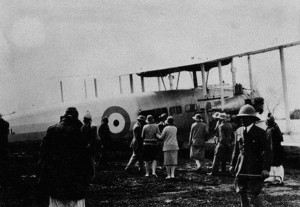
On December 14, 1928, the Legation was effectively surrounded by the tribal leader Habibullah Kalakani and his following of 3,000 Ghilzai tribesmen, who were attacking Kabul as part of the rapidly unfolding civil war. Habibullah stated that he did not wish to target the Legation, after having been confronted by the head of the Legation, who brought gifts of chewing tobacco when by chance the Afghan warlord was riding past on his white house. Nonetheless, the head of the Kabul Legation, Sir Francis Humphrys (himself a former RAF pilot), knew that his Habibullah’s followers were only barely under his control. It wasn’t long before they began to shoot periodically over the Legation’s low walls — sometimes the fire was intense and the British Military Attache reported his home had been hit 40 times, shattering his shaving mirror and singing his mustache. By some miracle, nobody was hit by any of the gunfire, however, though the Legation’s occupants knew that it was but a matter of time. As the Legation reported the situation by radio in a final message that begged the evacuation of the 300 women and children that were in the compound, electrical power was cut and the radio went dead.
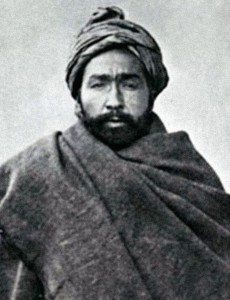
Re-Establishing Communications
With the Legation now out of communications, the RAF jumped into action. On December 18, 1928, an Airco DH.9A from RAF 27 Squadron was dispatched with two RAF servicemen on board. They carried a Popham Panel which was a set of signalling boards that could be arranged on the ground to convey by numbers that related to simple code books, a series of standardized communications. The pilot of the DH.9A was Flying Officer Claude William Leighton Trusk, accompanied by Leading Aircraftman Donaldson. However, when the Airco DH.9A arrived overhead, they found the armies of Habibullah and the King in continuous conflict directly outside the Legation itself — the battle lines were drawn and the Legation was caught in the crossfire.
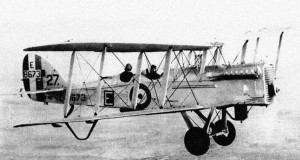
Descending lower, they could read a message on the grounds of the Legation that had been spelled out in torn bedsheets aligned on the ground. It warned them not to land and to not descend low and stated that “NOT LAND FLY HIGH ALL WELL” They dropped the Popham Panel but then thought that the Legation was deserted — they descended and flew at window height to try to determine if there were any survivors left from what they thought might have been a massacre. As they flew by, they could see all the windows were boarded up (later they would find this was to help protect the occupants from gunfire). On the low pass, their aircraft was showered with volleys of anti-aircraft fire. The DH.9A was hit by a total of 14 bullets and suffered significant damage. Critically, both engine’s radiator and oil pump were hit. Donaldson tapped out a Morse code message, “Been hit. Radiator burst. Landing Sherpur.” Meanwhile, F/O Trusk, covered in oil, climbed as he pressed the engine for the last revolutions and then glided in to land at nearby Kabul Sherpur Airfield, just two miles away (today a residential district on Kabul’s north side).
On arrival, the two men were arrested by the Afghans and accused of being spies. After some rough treatment, the Sherpur commandant came and picked them up, inviting them to lunch and clearing all the accusations. Relations improved instantly over tea. As they talked, Donaldson realized that he had a bullet hole in his flight suit — it had really been very lucky that they were not injured or killed in the volley of fire.
At first, the two RAF airmen thought they might wait out the conflict for a few days and so they checked into the posh Café Wali Hotel. It was a relaxed atmosphere and they hoped to repair the plane and make a flight in when the situation stabilized. Quickly, however, it became apparent there could be little hope of that. They knew the importance of the communications to the mission and thus, the two RAF airmen elected to take the long wave radio set from their stricken DH.9A and carry it across the lines on foot to the Legation. Arriving at the front lines, F/O Trusk and Donaldson instantly recognized the dangers ahead. The fire was unrelenting from both sides — what chance would they have of making alive to the Legation? Yet still, they elected to make a run for it, even as both sides were exchanging fire.
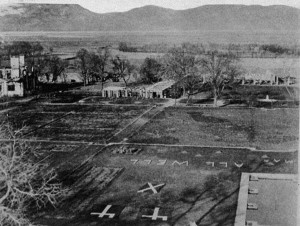
With bullets whizzing overhead and kicking up the dirt at their heels, they rushed toward the Legation carrying the heavy transmitter between them. An Afghan translator accompanied them. Stopping and crouching low whenever the firing increased, they worked their way toward the Legation in small runs. Whenever the firing stopped, they would leap up and run, only to dive down again for cover when both sides began shooting again. Time and time again, they repeated this until they managed to cover hundreds of yards in a stumbling run. Somehow, they had made it — surviving against all odds. With the transmitter, which was hooked up to the Legation head’s Mercedes car for power and with another airdropped Popham Panel that came over the next few days, Kabul could once again communicate with the outside world, though it was intermittent. Other DH.9As made higher altitude passes and dropped supplies, including an Aldis signal lamp, a wireless radio, some butter, coffee, and even meat and vegetables).
The Mass Evacuation and Rescue
On December 23, 1928, two days before Christmas, the slim hope of evacuation for the Legation became reality with the first flight. A Wapiti made a reconnaissance flight to confirm that they could land at Sherpur and then the Vickers Victoria from the British unit at Baghdad, RAF 70 Squadron, and three DH.9As flew the first shuttle run from the airfield at Sherpur, departing at 9:45 am. Habibullah’s forces were temporarily driven back 10 miles from Kabul by the King’s forces just the day before, thus fortuitously opening a window for the evacuation to begin. The Legation’s members could travel out first by foot to the Italian Legation at the edge of Kabul itself and then by car to Sherpur Airfield.
Though the Vickers Victoria was normally considered capable of flying just ten passengers at the altitudes of Kabul, nearly 6,000 feet, and based on the fact that the plane had to cross the 15,000 foot high mountains to India through the Khyber Pass and averaged an altitude of over 10,000 feet throughout the flight. Nonetheless, the plane had been stripped of extra gear and thus, the first flight carried 20 women and children and their baggage anyway. The passengers included Mrs. Humphrys (the wife the the Legation Minister) and three other English women, three English children (some were infants), four women from Indian with four maidservants (also Indian), and five other young children. The flight arrived at Peshawar at 11:30 am, the passengers having huddled together with blankets the entire trip to keep from freezing.
The baggage brought out was considerable given that the entire delegation was to evacuate with the key things of value that they had, including diplomatic documents and personal items. Furniture and household goods were left behind — each adult was allocated one suitcase of 20 pounds and each child a bag of 15 pounds. All of it was loaded onto the three Airco DH.9As which escorted the Vickers Victoria across the mountains of the Hindu Kush. Everyone knew this was the last they would see of Kabul given that the entire country had been overcome by the civil war and therefore, they wore multiple layers of clothing so as to carry out more (this helped in the cold of the flight, coincidentally) and also stuffed their pockets with additional items.
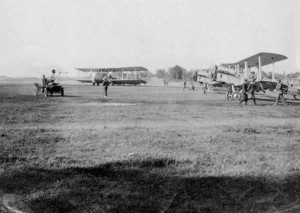
Over the next days, semi-regular shuttles began as two additional Vickers Victorias and a Hinaldi were flown in from Baghdad’s RAF 70 Squadron. Concurrently, flights began dropping leaflets over Kabul and over Habibullah’s forcing with messages that conveyed that there would be harsh consequences if the Legation were attacked — though how many Afghans could read was debatable (perhaps 2 percent?).
Despite the winter weather, the high peaks of the Khyber Pass (the planes had to fly above 15,000 feet) and the freezing cold, and increasing fighting on the ground near the Legation, the flights picked up pace. None of the planes were insulated against such weather and the passengers were nearly frozen to death after each flight as well as suffering from extreme airsickness from the mountain turbulence along the route. The destinations were Peshawar and Risalpur, in what was then a greater India. By New Year’s Day of 1929, all of the women and children had been evacuated — 153 women and 163 children in all. Two weeks later, as the men were being evacuated, the situation deteriorated further when Habibullah’s forces counter-attacked and prevailed to take control of the city itself. The Afghan royal militia, were seriously behind in military pay from the King. Thus, they had begun to fade away, spelling the end of Amanullah’s rule.
The British quickly decided that they would include the new King of Afghanistan (Amanullah had abdicated and fled to Kandahar, leaving his brother as the new king) and the Afghan royal family among those they would evacuate to India, even if potentially this carried grave political consequences for the continuation of the airlift. As it happened, the new King was able to negotiate a free departure if he would surrender the crown to Habibullah. For the British, the decision wasn’t political, but humanitarian, however, as everyone knew that without British protection and evacuation the royal family would be massacred. The evacuation of the Legation was allowed to continue under Habibullah’s rule and his forces did not fire on the Europeans as they made their way, day after day, to Sherpur Airfield for the flights.
No doubt a few payments were made to Habibullah to ensure his cooperation — and this allowed the RAF continued access. Habibullah also reduced the number of flights allowed to just two per day — the Vickers Victoria was used nearly exclusively in the service from that point onward, though sometimes the Hinaldis did their share.
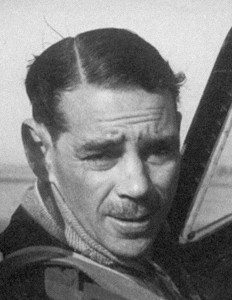
A Series of Near Disasters
Just three days later, on January 27, 1929, the extreme cold forced the Vickers Victoria down at Sarobi, Afghanistan. The pilot, Flight Lieutenant Ronald Ivelaw-Chapman (in later years, he would become Air Chief Marshal of the RAF), wrote about the forced landing in his official RAF report: “From the air, the surrounding countryside had looked entirely deserted. But within a few minutes of landing we were surrounded by a seething mass of wildly shouting, heavily armed, excitable Afghans, who surged around and in the machine and were raising a veritable Babel in their highly-pitched Pashtu.” Somehow, F/L Ivelaw-Chapman was able to secure the plane — again a close shave.
As February’s harsh winter descended on Kabul, the snows came, closing the airfield. Elephants and camels were used to drag plows and clear the field, keeping it in operation. Again, it was an innovative solution and the evacuation could continue, even as temperatures plummeted to a record -19 C. Day by day, the evacuation continued, two flights at a time. Slowly but surely all of the men were brought out and the Legation was abandoned.
With newly relaxed access, Habibullah’s men were allowing more aircraft to land at Sherpur and thus, on February 25, 1929, the last flights were made — seven Vickers Victorias (reflecting more that had arrived from Baghdad). These took the last of the Legation’s men out of Kabul, closing it down as Kabul was devolving into street fights between Habibullah’s and Amanullah’s men (the latter having reversed his earlier abdication and issuing orders from Kandahar). As the last flight took off, fires were raging across Kabul as Habibullah lost control of the Ghilzai tribemen who started rampant looting and burning the city. As well, when the flight flew over Jalalabad, they looked down at a ruined city, its once beautiful gardens stripped bare for firewood and many of its buildings reduced to rubble. Afghanistan had fallen into complete chaos.
On board the last Vickers Victoria was Britain’s Afghan Minister, Sir Francis Humphrys, who carried the Legation’s British Union Jack neatly folded under his arm. As well, after having spent several months in Kabul, F/O Trusk and Donaldson also flew out on that last airplane.

Aftermath
A tally of the numbers of each nation’s citizens and subjects demonstrates the extraordinary feat achieved. The RAF had flown out 369 British subjects (many of whom were Indians under British rule), 57 Germans, 49 Turks, 36 Afghans, 23 French, 25 Persians, 19 Italians, 5 Syrians, 1 Rumanian, 1 Swiss, and 1 citizen of the United States of America. This equated to a total of 586 people, of which 316 were women and children. A total of 84 flights had been successfully completed and the amount of baggage flown out amounted to 24,000 lbs — more than twice the originally allocated baggage allotment of 20 pounds for each adult and 15 pounds for the children (and this did not include the other “carry on items” and extra sets of clothing worn. While not the finest hour in British history, it was a major tragedy averted — all accomplished without loss of life.
To convey his appreciation for the RAF’s extraordinary effort, Sir Humphrys sent out a short cable, which read, “Many thanks kind message we owe everything to magnificent achievements of RAF. — Francis Humphrys Peshawar”. In the summer of 1929, both Humphrys and his wife were honored to kneel before the King of England, she being made a Dame of the British Empire and he a Knight Commander of the Order of Saint Michael and Saint George — it may have been the only time in history that a husband and wife had been so honored together before the British Crown.
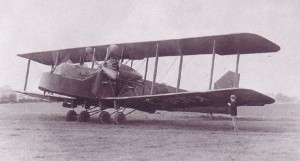
Final Thoughts
The RAF’s effort at Kabul in 1929 set the standard for future aerial mass evacuations, though it also raised the expectations of politicians as to what was possible. In fact, the dangers of overconfidence would emerge yet again in the years that followed and the RAF, alone and overwhelmed would have to step up to the task once again — but that is another story. As for Afghanistan itself, with the victory of Habibullah and the other tribesmen over the King and his Westernization reforms, the country was plunged back into tribal rule and charted a course away from modernization.
Habibullah Kalakani declared himself King and took on the new name, Habibullah Khadem-e Din-e Rasulallah (“The servant of the religion of the messenger of God” — some historians view the Taliban as a modern variation of Habibullah’s rule). Just nine months later, on November 1, 1929, however, Habibullah too was defeated and killed by Mohammed Nadir Khan, who declared himself to be yet another, new King of Afghanistan. The cycle of violence continued afterward.
Even today the effects of the 1928-1929 civil war remain a feature of Afghanistan’s politics and day-to-day life — the balance between modernization and tradition has proven forever elusive.
Today’s Aviation Trivia Question
With what types and numbers of airplanes was the King’s air force in Afghanistan equipped in 1928?

All sources I have consulted indicate that the Vickers Victoria of 70 Sqn of Chapman and Davis force landed on 29 January 1929, NOT 27 January 1929. For instance, the Times Newspaper Thursday, 31 January 1929, quotes a Reuters report from New Delhi dated 30 January 1929 which says ‘yesterday’, i.e., 29 January 1929.
We will double-check the date; it could be a typo. The source originally used for that was the RAF’s own record documents dating from the time of the events.
Thank you for posting such wonderful information about my great grand father Claude Trusk. This will be very useful to the future generations of my family such as my son and daughter. They will some day be able to read this and understand the meaning of the medals I have from Claude’s service during this mission.